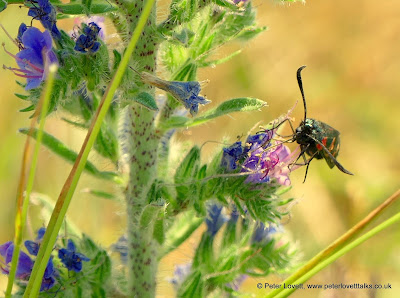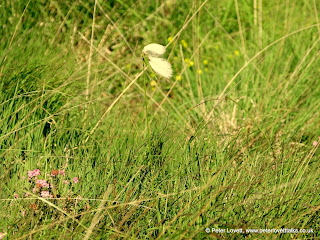Encouraged by
Butterfly Conservation Sussex, Ashdown Forest 2018 - Silver-studded Blues survey: details at
https://www.sussex-butterflies.org.uk/sites/ashdown2018.php the survey route (and a bit more) was walked in the expert company of William Coleman,
inter alia chairman of
Chailey Commons Society
Here are some pictures from the walk. Click on them to enlarge them.
A Fallow deer fawn.
A female Stonechat.
There were five male and one female Silver-studded Blue butterflies at this location.
A "Blue" or a Large Skipper? Lots of the latter raised false hopes on this afternoon.
William Coleman navigating and spotting rare plants and SsB's.
Bog Asphodel,
Narthecium ossifragum.
One of over 400 species of Sawfly?
There were two males and one female at this location.
An unidentified moth. Help please!
Spot the insect on the grass blade.
Large Skipper butterfly.
Wonderful displays of Bog Asphodel.
There were two male Silver-studded Blues at this location: you can't miss it it is near the foxglove!
A nice view of the South Downs and the "Long Man" above and unzoomed below.
An unidentified moth: help please.
A single male here.
And a single male here.
Cotton grass.
This is a real bonus as conservation work for butterflies is good for other species as well.
There are over a hundred Heath spotted orchids,
Dactylorhiza maculata here; many already gone to seed leaving many plants in shade still flowering.
This is the finest number of these orchids that I have ever seen in Sussex. Nice one Silver-spotted Blue conservationists!
There were dozens of tiny, newly emerged Small Red Damselfly tenerals.
This one appears to be eating a pollen beetle or similar insect. Other Damselflies seen were, Large Red and Azure Blue. Dragonflies included Broad-bodied chasers mating and egg laying; and an Emperor.
https://british-dragonflies.org.uk/sites/british-dragonflies.org.uk/files/images/GardenDragonflies_0.pdf
Two dogs were swimming after a ball thrown into the small ponds, stirring up the mud. And if they have been treated for fleas, then the pond life insects may also now be wiped out.























































































